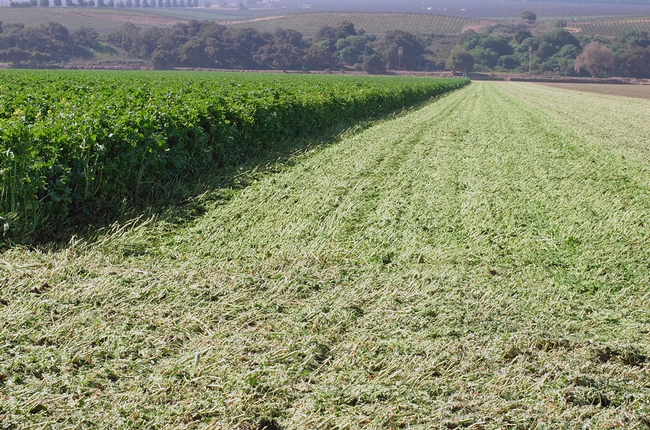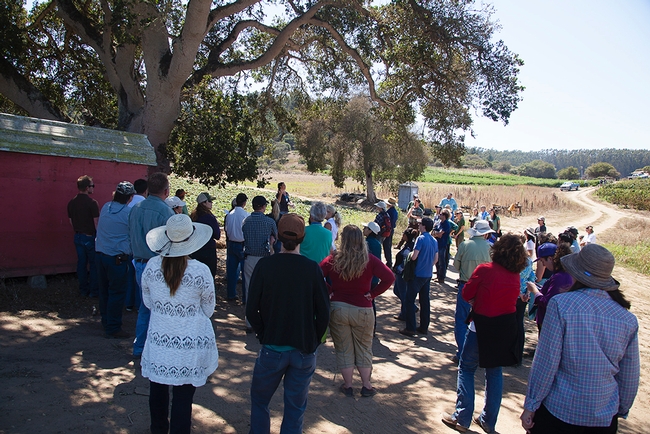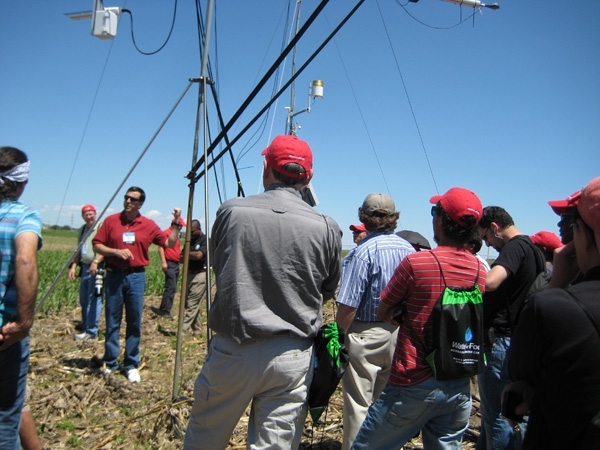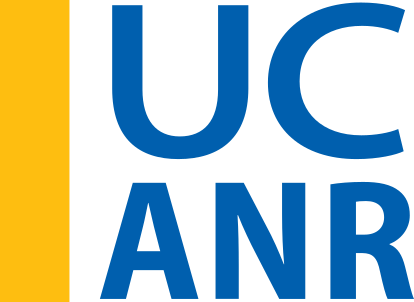- Author: Pamela Kan-Rice

To help growers and food safety professionals achieve all of these important goals, UC Cooperative Extension has launched a free online course.
“Actions that farmers take to protect food safety may affect natural resources, and conservation practices may affect food safety,” said Mary Bianchi, UC Cooperative Extension advisor in San Luis Obispo and Santa Barbara counties, who oversaw design of the course.
The intent of the training is to demonstrate that communication between food safety professionals and growers can help to achieve a balance between food safety and sustainability.
“Our co-management course will help food safety professionals better evaluate the risk of conservation practices,” said Bianchi.
“For example, cover crops attract beneficial insects, help control soil erosion and improve soil quality, but they may attract wildlife,” she said. “In the course, we demonstrate frank conversations between food safety auditors and growers about strategies for minimizing the potential risks of crops being contaminated by animal feces. Growers can often provide existing examples, such as monitoring programs or temporary fencing that excludes wild and domestic animals from produce fields.”
The course also provides growers with tools to evaluate their strategies for managing food safety and sustainability.
“After the training, growers and auditors will be better prepared to engage in realistic and frank discussions of co-management strategies used in crop production,” Bianchi said.
The free online co-management course and related resources are online at http://cesanluisobispo.ucanr.edu/Co-management_of_Food_Safety_and_Sustainability.
This project was funded by a $39,650 grant from the University of California Agriculture and Natural Resources.
A video describing co-management practices from farm to fork can be viewed at https://www.youtube.com/watch?v=_IoQ-8OEuc4&feature=youtu.be.
The University of California Global Food Initiative aims to put the world on a path to sustainably and nutritiously feed itself. By building on existing efforts and creating new collaborations among UC's 10 campuses, affiliated national laboratories and the Division of Agriculture and Natural Resources, the initiative will develop and export solutions for food security, health and sustainability throughout California, the United States and the world.
- Author: Pamela Kan-Rice
Growers, conservationists, food safety professionals discuss food safety, water quality

To help farmers and growers efficiently achieve the best results, the University of California Cooperative Extension, in collaboration with the Farm Food Safety and Conservation Network brought together 80 people on Aug. 21 for the sixth annual Food Safety and Water Quality Co-management Forum in Watsonville.
"The Farm, Food Safety & Conservation Network is leading the way in co-management of California's agricultural resources,” said Craig McNamara, president of the California Board of Food and Agriculture. “Their recent forum on food safety and water quality brought together the best and the brightest from the Central Coast region to discuss these important issues."
McNamara, who was the keynote speaker, provided his perspective on broadening the view of food safety to include managing agriculture within the context of sustainable agriculture, ecosystem conservation and food insecurity. He also related the discussion of co-management to California’s Ag Vision 2030, a stakeholder-driven process of setting priorities for the future of California agriculture.
Forum participants heard the latest information on designing on-farm practices that might create co-management solutions for nutrients, pesticides and pathogens in the production environment. They also engaged in frank discussion of co-management challenges and solutions at all levels of the supply chain, from large company policies to field-level practices of individual growers.
“Research results show us that we do know quite a bit’ explained Mary Bianchi, UC Cooperative Extension advisor in San Luis Obispo and Santa Barbara counties. “The question now is how do we put that knowledge into action? How can we move towards design and management of on-the-ground management practices and policy programs that reflect our evolving understanding?”
The forum concentrated on the types of practices and policy programs that may help, and discussed strategies, both field-based and policy-driven, that might support progress in addressing persistent resource concerns relevant to agricultural production.
“The forum presents a great opportunity for anyone interested in learning about the key co-management issues on the Central Coast and is a great way to network with experts in the field,” said Afreen Malik, Ocean Mist Farms manager of Food Safety and Environmental Stewardship.
Scientists led a discussion on the fate and transport of nutrients, pesticides, and pathogens and how science can be applied to design practices for co-management decisions in the field. The scientific panel included Tim Hartz, UC Cooperative Extension specialist in the Department of Plant Sciences at UC Davis; Rob Atwill, UCCE specialist in the School of Veterinary Medicine and director of the Western Institute for Food Safety and Security; and Brian Anderson, UC Davis specialist based at the Marine Pollution Studies Laboratory at Granite Canyon.
A panel of industry leaders discussed how policy changes and decision-support tools could support sound co-management. The panel included Ken Harris, executive officer of the Central Coast Regional Water Quality Control Board; Asif Maan, branch chief of CDFA Feed, Fertilizer, and Livestock Drugs Regulatory Services; Kris Gavin of Growers Express; Scott Horsfall, CEO of Leafy Greens Handlers Marketing Agreement; and Lisa Lurie of Santa Cruz Resource Conservation District.
Following the panel discussions, participants visited an organic vegetable and berry farm near Watsonville. The landowner, growers and food safety professionals discussed how they manage for both food safety and environmental quality, which some people see as conflicting priorities.
“I don’t see any conflicts between properly implemented co-management practices and protection of water quality,” said Ken Harris, executive officer of the Central Coast Regional Water Quality Control Board after completing a field exercise at the ALBA Triple M Ranch outside Watsonville.
Brendan Miele, director of California farming operations for Jacobs Farm/del Cabo Inc., added, “I would say the same thing, but would change that to food safety.”
Participants were surveyed before and after the forum. “After the forum, 88 percent of the participants felt they understood co-management principles, 14 percent higher than before the forum,” Bianchi said, “and 85 percent of the participants felt that they could incorporate what they learned into the decisions they make.”
- Author: Jeannette E. Warnert

“We want to introduce more farmers to these proven technologies,” said Jeff Mitchell, UCCE specialist in the Department of Plant Sciences at UC Davis and field day coordinator. “We’ve done research here, and there’s a lot of work from other areas showing that these systems work and they save water, reduce dust, store carbon in the soil and save farmers money.”
This year, the event has been expanded to include an afternoon bus tour to three San Joaquin Valley farms where conservation agriculture systems are already being successfully implemented. Registrants will gather at 1 p.m. at the UC Westside Research and Extension Center, 17353 West Oakland Ave., Five Points, to load the buses.
The farm tour visits:
- Johnny and Joann Tacharra Dairy in Burrel. The Tacharras will explain their plans to apply dairy waste water through an overhead irrigation system to grow forage crops.
- Armando Galvan of Five Points Ranch. Galvan will show how he refined his irrigation system to apply water to vegetable and row crops. Galvan installs special nozzles and boom configurations on his overhead irrigation drop lines that are designed to improve water infiltration and avoid ponding and crusting on the soil surface.
- Scott Schmidt of Farming ‘D’ Ranch in Five Points. Schmidt will discuss the new management strategies that must be applied to successfully implement new agricultural systems.
Following the tour, the participants reconvene at 4 p.m. at the UC Westside REC for a workshop on the economic and environmental benefits of conservation agriculture systems. The event continues with a free barbecue dinner, entertainment by the Wheelhouse Country Band and a keynote address by Suat Irmak, director of the Nebraska Water Center and professor of biological systems engineering. The Water Center was established at the University of Nebraska by congressional mandate in 1964. Nebraska farms currently lead the nation in adopting precision irrigation systems.
Following Irmak’s presentation and discussion, Mitchell will name the 2013 Conservation Tillage Farmer Innovator of the Year award winner.
The expanded event coincides with a concerted effort by the Conservation Agricultural Systems Innovation (CASI) Center to grow the conservation agriculture movement in California. CASI is a diverse group of UC researchers, farmers, public and private industry and environmental groups formed to develop and exchange information on sustainable agricultural systems for California row crops.
“In each century, there are just a handful of times when agriculture can transform itself in revolutionary ways,” Mitchell said. “There is growing evidence that today presents one of those rare chances for agriculture in the San Joaquin Valley to reinvent itself.”
The event is free but pre-registration is requested to help with planning for the bus tour and dinner. Please R.S.V.P. by email to Diana Nix at dlnix@ucdavis.edu or by completing the online survey.
- Author: Jeannette E. Warnert
- Contact: Jeffrey P Mitchell
The UC Conservation Agriculture Systems Initiative challenges Californians to look 100 years, or even 500 years, into the future and imagine how today’s common agricultural practices will have impacted the environment and society.
The United Nations estimates world population in 2300 will be about 9 billion. There is likely to be significant development in the ensuing 300 years that reduces the amount of land for farming.
“We have to be able to do more with less,” said Jeff Mitchell, UC Cooperative Extension cropping systems specialist, echoing a common theme repeated by speakers at the launch of the UC Conservation Agriculture Systems Initiative (CASI) Jan. 27. “The global demand for food will be immense.”

Mitchell, other researchers and many innovative farmers have documented in more than 14 years of field research that changes in traditional farming practices – employing such technologies as precision irrigation, integrated pest management and conservation tillage – cut costs $75 to $150 per acre, reduce dust and diesel fuel emissions 60 to 80 percent, and prevent evaporation of about 4 inches of water per season from the soil surface.
This sort of objective data, plus favorable economic analyses and access to high-technology conservation equipment, are important factors in motivating farmers to change their practices, but they are not the only factors, Mitchell said. The Institute is committed to not only demonstrating and communicating the documented benefits of conservation agriculture but also identifying the drivers behind behavior change. The goal is converting 50 percent of California crop acreage to conservation practices by 2028.
“The cornerstone of sustainability is behavior change,” said Ron Harben of the California Association of Resource Conservation Districts, one of the Initiative’s founders. “Simply providing information has little or no effect on what people do.”
In parts of the U.S. and the world, conservation agriculture is common practice. World leaders in conservation agriculture include Brazil, Argentina and Paraguay, Western Australia and Canada. Within the next ten years, Mitchell reported, more than 85 percent of the cropland in the three South American countries is expected to be converted to conservation agriculture. Adoption rates are also quite high in parts of South Dakota, Nebraska, the Pacific Northwest, and areas throughout Alabama and Georgia. Yet implementation in California is still low.
In 2010, conservation tillage systems accounted for about 14 percent of the acreage in silage and grain corn, small grains for hay, silage and grain, tomatoes, cotton, dry beans, and melons in the nine-county Central Valley region. This was an increase from about 10 percent in 2008. Minimum tillage practices were used on about 33 percent of crop acreage in 2010, up from about 21 percent in 2008.
Mitchell said the implementation trends around the world, in the U.S. and in California “lend a certain inevitability” to its wide adoption in the San Joaquin Valley.
“This is not just about making a profit and optimizing yields,” Mitchell said. “By minimizing soil disturbance, preserving surface residue and including a greater diversity of crops in the rotation we are improving the soil resources and deepening the soil in an improved condition.”
The keynote speaker at the CASI launch was Hanford dairy farmer Dino Giacomazzi, a long-time innovator in conservation agriculture. Giacomazzi discovered conservation agriculture not long after taking over day-to-day operations of the Giacomazzi dairy from his father.
“It’s less work for more money,” Giacomazzi said. “Why aren’t people doing it? What’s the holdup?”
Perhaps in answer to his own question, Giacomazzi shared the reaction of his father to the new system being used on their farm. In their last conversation, the elder Giacomazzi lamented that, “Everything I’ve ever done, you’ve undone,” his son related at the meeting.
Dino Giacomazzi said many farmers’ tendency to be “enthralled” with tradition, their fierce independence, aversion to risk and fear of derision from neighbors contribute to their resistance to change. But accepting change is what is needed to adapt to a rapidly changing world.
Giacomazzi said the new Institute will play an important role in supporting farmers as they convert to conservation practices.
“This can’t be just a launch,” Giacomazzi said. “We must make this happen. Stay in touch.”
A video of the complete CASI January 27 launch meeting will soon be available at the Institute’s website http://ucanr.org/CASI.


